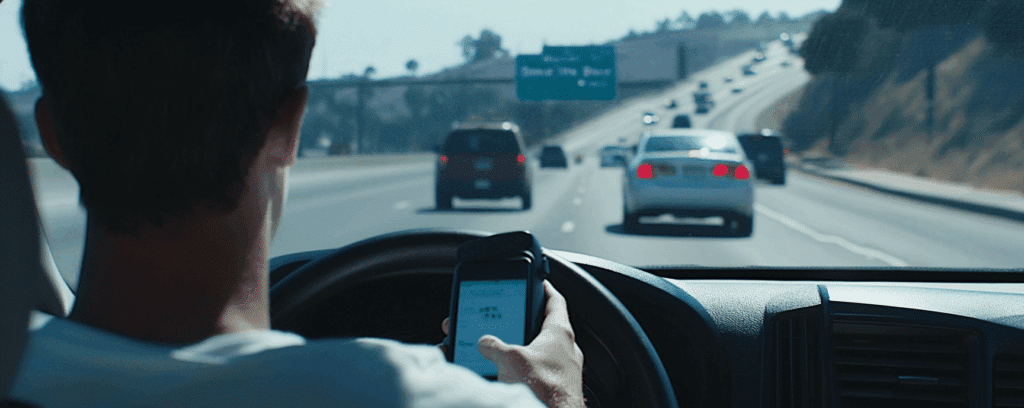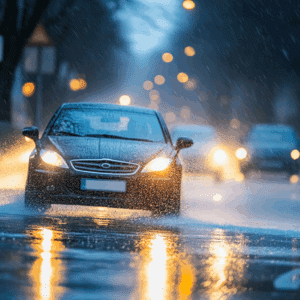What Are the Top 5 Causes of Car Accidents and How to Avoid Them?
Last updated Tuesday, April 22nd, 2025

Wondering what are the top 5 causes of car accidents? Car crashes often stem from a handful of prevalent factors. This article reveals the most common reasons behind car accidents and offers insights on how to avoid them, helping you stay safe on the road.
Key Takeaways
- Driver behavior, including distracted and impaired driving, is the leading cause of car accidents.
- Maintaining vehicle safety through regular maintenance and adhering to speed limits can significantly reduce accident risks.
- Proper responses to poor weather conditions and understanding roadway hazards are crucial for preventing accidents.

Get Your FREE Case Review,
In Person or Virtually Online
The Leading Causes of Car Accidents
Car accidents occur due to a myriad of factors, but driver behavior remains the leading cause. Here are some of the most common causes of driver behaviors that significantly increase the risk of car accidents caused:
- Distracted driving
- Speeding
- Reckless driving
- Impaired driving
By understanding these behaviors, drivers can take steps to reduce their risk of being involved in an accident.
Addressing these behaviors can greatly enhance road safety.
Distracted Driving
Distracted driving is the top cause of car accidents, responsible for approximately 3,000 traffic fatalities each year in the U.S. Whether it’s texting, eating, or using a cell phone, distracted driving includes a range of activities that divert a driver’s attention from the road. This lapse in focus can prevent drivers from noticing hazards, leading to severe crashes.
Many drivers underestimate the danger of distractions. Adjusting controls, eating, or even being preoccupied with work or family matters can significantly reduce road safety. Distracted drivers texting while driving are particularly hazardous, as it increases the chance of a car accident substantially.
Speeding
Speeding is responsible for about 29% of all fatal car accidents annually. When drivers exceed speed limits, they reduce their ability to react to unexpected situations and increase the severity of accidents. Sudden braking at high speeds can lead to dangerous scenarios, not just for the speeding driver but also for others on the road.
Maintaining control becomes significantly harder when speeding, often resulting in losing control. The increased stopping distance and the reduced time to react to obstacles can lead to severe crashes. Speed limits are in place to ensure that drivers can safely navigate the roads and react appropriately to unforeseen circumstances.
Drunk Driving
Every day, approximately 37 people die from accidents involving drunk driving in the U.S. Drunk driving impairs judgment, motor skills, and reaction times, leading to risky behaviors like speeding, running red lights, and hitting pedestrians. These actions significantly increase the likelihood of many fatal car accidents.
One crucial guideline is to never drive under the influence of alcohol or drugs. Arranging alternative transportation, such as a designated driver or a ride-sharing service, can prevent these dangerous situations. Staying sober behind the wheel is essential for road safety.
Reckless Driving
Reckless driving behaviors include intentional risks like speeding, running red lights, and tailgating. These actions create unpredictable traffic situations that can lead to severe crashes. For instance, tailgating reduces the reaction time available to avoid a collision, significantly increasing accident risk.
Inexperience and reckless behaviors among teen drivers are a significant concern, contributing to many accidents. Being predictable in driving actions can drastically reduce the chances of accidents. Following traffic rules, such as stopping at red lights and stop signs, is essential for maintaining road safety.
Poor Weather Conditions
Adverse weather conditions contribute to over 418,000 injuries annually. Rain, fog, snow, and ice can significantly reduce visibility and road traction, making it harder to control a vehicle. In such conditions, it’s crucial to drive at a slower pace to maintain control.
Using the right equipment, like fog lights in foggy conditions and proper tires in snow, can enhance safety. Increasing the following distance and driving cautiously in inclement weather can help prevent accidents.

Get Your FREE Case Review,
In Person or Virtually Online
Understanding the Impact of Driver Behavior on Car Accidents
Driver behavior plays a pivotal role in the occurrence of car accidents and car crashes. Risky behaviors, such as speeding, drunk driving, and running red lights, significantly increase the likelihood of serious car accidents, often due to driver error. When drivers run the risk of engaging in these behaviors, the consequences can be severe.
Driving courteously and defensively reduces crash probabilities and enhances road safety. It is essential to drive safely.
Aggressive Driving
Aggressive driving includes speeding, running red lights, road rage, and tailgating. These behaviors create unpredictable traffic situations and increase the risk of accidents. Road rage, characterized by aggressive and angry behavior from drivers, is particularly dangerous.
Aggressive driving not only endangers the aggressive driver but also other motorists. Staying calm and patient on the road can prevent accidents and promote safety.
Drowsy Driving
Drowsy driving can be as detrimental as driving under the influence, severely impairing a driver’s reaction times and decision-making skills. Driver fatigue can cause you to fall asleep, increasing the risk of accidents, so ensure adequate rest before falling asleep.
Improper Turns
Improper turns cause unexpected hazards and potential collisions. Failing to signal, not checking for other vehicles, and making sudden turns can lead to accidents the wrong way. Signaling intentions and checking surroundings, including observing traffic signals, the stop sign, and turn signals, can help avoid improper turn accidents.
Vehicle-Related Factors Contributing to Car Accidents
Vehicle maintenance and defects also play a significant role in car accidents. Regular preventive maintenance helps prevent accidents caused by car defects. Ensuring that safety features are in working order and addressing mechanical issues promptly can enhance road safety.
Tire Blowouts
Tire blowouts account for approximately 22.41% of car accidents. When a tire blows out, the driver can lose control of the vehicle, leading to accidents. Ensuring proper tire maintenance and addressing manufacturing defects can reduce the risk of blowouts.
Regularly check tire pressure and tread depth, and replace worn tires to prevent blowouts. Proper tire maintenance is crucial for maintaining vehicle control and ensuring safety on the road.
Vehicle Defects
Mechanical failures contribute to 5.64% of car accidents. Older vehicles, especially those over ten years old, are more prone to mechanical issues. Addressing problems promptly by consulting a professional can prevent accidents caused by vehicle defects and reduce the risk of human error. Understanding the common causes of car issues can help in maintaining your vehicle effectively.
Regular vehicle maintenance, such as checking brakes, lights, and critical systems, ensures a vehicle’s safety. Preventive maintenance can reduce the likelihood of accidents caused by mechanical failures.
Environmental and Roadway Hazards
Environmental factors and road conditions also contribute to car accidents. Rain, snow, and ice can make roads slippery and reduce visibility, increasing the risk of accidents happening. Potholes and construction zones require heightened vigilance to prevent accidents.
Construction Zones
Confusion often arises in construction zones, significantly increasing the likelihood of accidents. Drivers may struggle with adapting to modified traffic patterns, leading to increased risks. Rushing through construction zones can further raise the likelihood of accidents as drivers fail to adjust their speed appropriately.
Being aware of construction zones and driving cautiously can help prevent accidents. Navigating new traffic patterns and following posted signs enhances safety in construction zones.
Animal Crossings
Collisions with animals crossing roads can cause significant damage and injuries, especially at higher speeds. Animal crossings are more prevalent in rural areas and regions with wildlife, increasing the risk of collisions. Higher speeds reduce the time a driver has to react to an animal crossing, leading to more severe collisions.
To prevent accidents, drivers should remain vigilant in areas marked with animal crossing signs and reduce speed when necessary. Being aware of the surroundings and slowing down can help avoid accidents.

Get Your FREE Case Review,
In Person or Virtually Online
Tips for Preventing Car Accidents

Here are some essential techniques for reducing the risk of accidents:
- Defensive driving techniques
- Paying attention to surroundings
- Adhering to speed limits
- Avoiding the influence of drugs and alcohol before driving
These practices are crucial for maintaining cognitive function and decision-making while on the road.
Stay Focused
Staying focused while driving is crucial to preventing accidents and ensuring safety on the road. Drivers should avoid using electronic devices, such as cell phones, which can significantly distract from driving. Eating while driving can also lead to distractions and should be avoided.
Full attention on the road helps drivers react promptly to situations, reducing accident risk.
Obey Speed Limits
Adhering to speed limits is fundamental to safe driving. Following speed limits reduces the risk of severe crashes by promoting safer driving behavior.
Following speed limits helps maintain vehicle control and ensures road safety.
Don’t Drive Under the Influence
Drunk driving impairs judgment and motor skills, leading to severe crashes and fatalities caused by drunk drivers. Despite ongoing awareness campaigns, many drivers still ignore the dangers and choose to drive while intoxicated.
Always stay sober when driving; use alternative transportation if under the influence of alcohol or drugs.
Maintain Your Vehicle
Regular servicing and maintenance are essential for keeping a vehicle safe. Promptly addressing mechanical issues and ensuring that safety features work can prevent accidents.
Proper maintenance helps ensure that a vehicle performs reliably on the road.
Adjust for Weather Conditions
It is important to adjust driving habits during poor weather conditions. This can help ensure safety on the roads. In wet or icy conditions, it is advised to slow down considerably. Taking extra precautions during poor weather significantly reduces accident risks.
Maintaining a three-second following distance in adverse weather enhances safety.
What to Do If You Are Involved in a Car Accident
In the unfortunate event of a car accident, knowing the right steps to take can make a significant difference. Ensuring safety, calling law enforcement, and gathering evidence are crucial actions.
Identifying fault, seeking legal help, and understanding the steps to take can help manage the aftermath of an accident and ensure that all involved parties are taken care of.
Ensure Safety
Immediately after an auto accident, check for severe injuries to yourself and passengers. Ensuring that all vehicle occupants are safe from further harm is the top priority. If possible, move to a safe location away from traffic after a serious car accident.
Stay at the scene to exchange information and assist if anyone is hurt.
Exchange Information
After ensuring safety, exchange information with the other drivers involved in the accident. Provide your name, contact details, and insurance policy information. If another driver refuses to share their information, document their vehicle’s license plate and report it to the police.
Document the Scene
Documenting the accident scene is crucial for legal and insurance purposes. Photograph the damage, vehicle positions, and relevant road signs or signals.
Collect eyewitness contacts and ensure an official accident report is filed by speaking to law enforcement.
Frequently Asked Questions
What is the biggest cause of car accidents?
The biggest cause of car accidents is distracted driving, which significantly increases the risk of collisions. Addressing distractions while driving is essential to enhance safety on the roads.
How does speeding contribute to car accidents?
Speeding significantly impairs a driver’s reaction time to unexpected events and escalates the seriousness of accidents. Therefore, adhering to speed limits is crucial for road safety.
What should I do immediately after a car accident?
Immediately check for injuries and move to a safe location, then stay at the scene to exchange information and assist anyone who may be hurt.
How can I prevent accidents caused by poor weather conditions?
To prevent accidents in poor weather conditions, adjust your driving by slowing down, and ensure your vehicle is equipped with fog lights and suitable tires. This proactive approach can significantly enhance your safety on the road.
Why is regular vehicle maintenance important for preventing accidents?
Regular vehicle maintenance is crucial as it keeps safety features operational and helps avoid mechanical failures that could result in accidents. Prioritizing maintenance contributes significantly to overall road safety.


